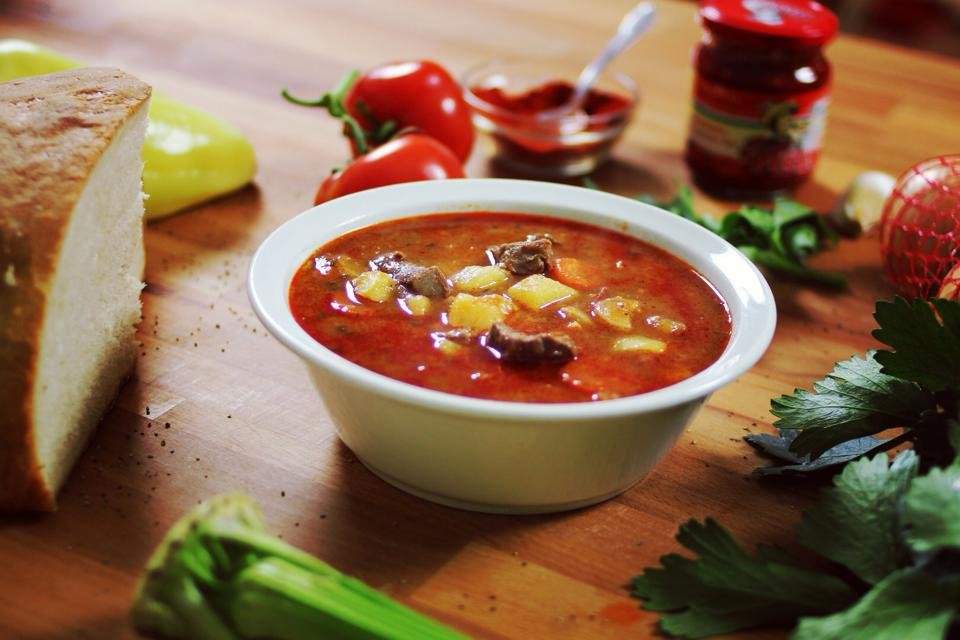Guide to Hungarian outdoor cooking – Bográcsozás

If there is one thing that can bring Hungarians outside, whether it is summer or winter, it is the typical Hungarian practice of preparing food outside, in a cauldron or kettle hanging above a fire. We call it “bográcsozás” and it is not just simply cooking, it is a ritual that brings together the family and friends, no matter the size or importance of the event. This method gives a special taste to the food, which would be impossible to reproduce in a kitchen. Magyarorszagom.hu shares some interesting facts with us about outdoor cooking and the history of the cauldron.
The most popular dish to prepare in a kettle or cauldron is the goulash. There are many different recipes, and every chef or housewife has their own tips, special ingredients or a preparation method that they perfected over the years.
Read about the history of the Goulash in our previous article, where you can also find out about different goulash variations.
In case you want to try your hand at preparing goulash, check out our recipe:
[button link=”https://dailynewshungary.com/recipe-of-the-week-goulash-soup/” type=”big” newwindow=”yes”] Goulash recipe[/button]
The Hungarian gastronomy is world-famous for a reason: it is not bound by rules, it is always changing, adapting, becoming more colourful every day.
And this is not only because of the work of master chefs, but every Hungarian who cooks at home is responsible for this evolution because they are always trying to incorporate some new flavours from other cultures.
The speciality of Hungarian dishes lies in the most basic steps. Using lard for frying is in itself a pretty unique idea – and most Hungarian dishes start with this. The next ingredient is the onion, usually accompanied by more onion, and of course the paprika. These are the most basic ingredients which are at the core of almost every Hungarian dish, be that a soup or a stew.
The finishing touches are also mostly the same – a great number of Hungarian dishes are served with sour cream.
Perhaps the most interesting aspect of the Hungarian gastronomy is cooking in a kettle hung above an open fire. Making goulash, for example, outside is not like cooking in a kitchen. Preparing food on a stove top is pretty easy compared to cooking in a huge cauldron. This requires a lot of precision and attention to detail. Of course, the result is worth all this trouble. A great number of Hungarian dishes that we nowadays prepare in the kitchen were once cooked outside.
During the Árpád-dynasty (1000 – 1301) clay cauldrons were used. The shape of these cauldrons was designed in a way that the fire did not burn the ropes holding the cauldron up. With time the shape changed, while in the Transdanubia and Great Plain regions of the country the cauldrons were pear-shaped, in Transylvania they were mostly hemispherical. Horsemen in the early middle ages already used cauldrons.
The best way to cook meat and vegetables seemed to be in a cauldron hung above the fire, which is how we do it even today.
The first Hungarians settling in the Carpathian Basin brought with themselves the early version of the clay cauldron. Archaeologists say that the origin of these pots must be somewhere in the Don region. The Hungarian word for cauldron is “bogrács”, which comes from the Turkish bakraç, meaning copper cauldron. Serfs (semi-free peasants, in Hungarian “jobbágy”) had cast iron cauldrons, which became more and more common in the 1700s and soon completely replace the copper cauldron. Nowadays we mostly use enamelled cast iron cauldrons, but the traditional clay cauldrons are getting more and more popular.

Hungarian dining
In Hungary, lunch is the biggest meal of the day. It starts with a rich soup, which is very filling, especially for foreigners who are not used to eating soups. Many ingredients can make it into a soup – like noodles, potatoes, meat and other vegetables. Sometimes the main course – after the soup – is a kind of pasta with jam, cottage cheese, walnut or poppy seeds. Of course, you do not have to eat pasta after the soup. There is another Hungarian dish that leaves most foreigners perplexed: the “főzelék”. It is a dish of boiled seasoned vegetables, thickened with sour cream and flour, often eaten with stew, eggs and bread.
Rules of cooking in a cauldron
- Everything starts with choosing the recipe and getting the proper ingredients.
- All the ingredients need to be readily available since it is very important that they get added at the perfect time. Do not forget to keep a wooden spoon and a kitchen towel with you at all times!
- Choose a cauldron that is best for the type of dish you want to prepare. Different cauldrons are used for different dishes.
- Be cautious! Setting a fire outside can be dangerous, make sure that you surround the fire pit with rocks. Only start the fire when the pit is ready and the area clean.
Source: magyarorszagom.hu





